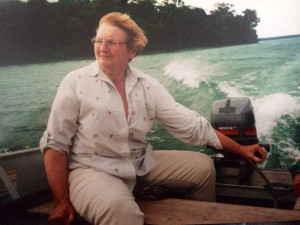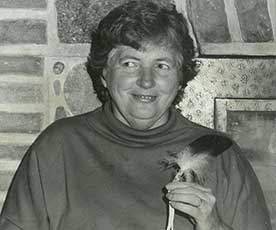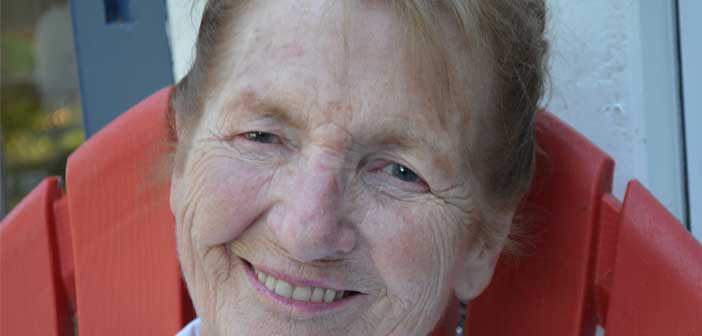Manitoulin Island’s most beloved stalwart of the arts
Marion Seabrook was born on Lake Mindemoya’s Treasure Island and never has a birthplace been more appropriately named for Ms. Seabrook was, over the course of her long life, demonstrably Manitoulin Island’s own ‘national treasure.’
Ms. Seabrook lived a life that was truly well spent, as testified to by the host of former colleagues, students, friends and family who have been sharing stories of her life and the impact she had on theirs. While Ms. Seabrook was a person who eschewed the limelight rather than sought out its glare, the limelight nevertheless often centred on her, the by-product of countless projects and endeavours she initiated to enrich the lives of Island residents.
Stretching back over several decades’ gems, demonstrating her impact on our community, cascade from the pages of The Expositor. She would undoubtedly have been scandalized by such a description of her accomplishments, but for any reader of this paper’s back editions, reaching such a conclusion would be inevitable.
Born Jean Marion Hodgson to parents Joseph and Jean (Tustian) Hodgson on Treasure Island, Ms. Seabrook described her earliest memories to Now and Then columnist Petra Wall as being governed by a clock that consisted of daytime “when the sun slipped in the window” and “nighttime, when my dad held my pajamas in front of the fire to warm them,” freeze up, “when the boats and docks were hauled up (at the family’s tourist lodge on Treasure Island),” breakup “when giant pieces of ice crashed against the rocks” and Christmas time “when I smelled mom’s molasses cookies baking.” Her earliest memory was of a Newfoundland puppy she had wanted for Christmas and which her father had raced across the ice to bring back in time for Marion to find in safe vicinity of the Christmas tree. “When I felt the rough lick of his tongue all over my face, I knew for sure that Christmas had come,” she told Ms. Wall.
Ms. Seabrook’s early interactions with the education system most definitely did not foreshadow a career as an educator. Her earliest lessons were conducted by correspondence and it was not until Grade 6 that her family moved to the mainland and she attended a regular school. The subjects of English, new history and science “were brand new subjects for me so I was put back into Grade 5 to catch up,” she told Ms. Wall. The culture shock of the schoolyard was exacerbated when she was unfairly accused of the plagiarism of a story similar to a student who sat behind her in class. The lack of trust left a bitter taste that lasted for many years. Her spirit was indomitable, however, and Grade 13 was succeeded by a general degree from the University of Toronto and later complemented by a certificate from the Institute of Child Studies.
Returning to Manitoulin, she renewed her childhood friendship with Jack Seabrook. They married on October 10, 1953 and eventually renovated and expanded the 1920s farmhouse on the edge of Mindemoya where she and her husband Jack lived out their lives and raised Cathy, Debra, John, Diana, Mark and Vanda.
Ms. Seabrook fell into her first brush with teaching almost by accident when she was looking after the daughter of Dr. Jack McQuay, whom the good doctor reportedly had to pry loose from a table leg at Ms. Seabrook’s home. Dr. McQuay suggested she start a formal day nursery and she intimated that she had an interest. “He called me back a day later with a location for the nursery,” she said. She ran the nursery for three years and, by her own admission, “thoroughly enjoyed myself.”

Her next venture along the career path was teaching English to high school students, where she soon found herself the head of the English department.
“She was my department head,” recalled younger sister Joanne (Hodgins) Smith. Although Ms. Smith had no experience with teaching, her sister Ms. Seabrook simply told her, “there’s nothing to it.” Ms. Smith had other plans, including hitchhiking across Europe for the summer. Still, she found herself teaching upon her return that fall. Ms. Smith eventually went on to teach music at schools across the Island and later at the nascent Kenjegewin Teg, in both the portables edition and the new facility.
Three of Ms. Seabrook’s children were Native children, adopted by the couple and that connection was to play a role in her development of what was to be one of the first (if not the first) course in ‘Native Studies’ in a school board in the province. She worked with the late Mary Lou Fox, founder of the Ojibwe Cultural Foundation, and Kate Roy, as well as a number of other high school staff and the Secretary of State in Ottawa. “The ultimate reward of this program was the sheer joy the students displayed during the field trips to far-away places,” she relayed to Ms. Wall.
Students in the program travelled to both the east and west coasts of the country, visiting and billeting with families in those communities, with Island First Nations reciprocating.
Ms. Seabrook was honoured in 2009 for her Native teaching achievements with a surprise at a ceremony during that year’s Homecoming Weekend, which also featured a reunion of students from Manitoulin’s original high school. Lewis Debassige, one of Ms. Seabrook’s homeroom students at the old Mindemoya High School, was the first student from his community of West Bay (now M’Chigeeng) to graduate from Grade 13 and he described the positive impact she had upon his education. He recalled his interactions with another teacher that led to his becoming an indifferent student, only working hard enough to barely pass each year. Ms. Seabrook broke that trend. “She was a teacher who loved us and inspired us,” he told writer Jan McQuay following the ceremony in 2009. Mr. Debassige went on to a very distinguished career in education, becoming a director of education and one of the founding forces behind Kenjegewin Teg Educational Institute. In helping to organize the 2009 reunion celebrations, Mr. Debassige recalled the original Mindemoya High School motto was “Honour, Truth, Valour” and he determined that a “truth” was missing from those celebrations. M’Chigeeng Chief Isadore Bebamash and Mr. Debassige presented Ms. Seabrook with a “beautiful” quill box in honour of her efforts on behalf of her students.
“I had little knowledge of Native Studies, but I did know how to teach,” said Ms. Seabrook when a Native Studies course was mandated at the then-new Manitoulin Secondary School when it opened in 1969, replacing the three older smaller Manitoulin High Schools. “So I offered to teach the class. I told them that it was strange for a white woman to teach Native Studies, so we would learn together.” Trips to Saskatchewan, a Micmac community in Cape Breton and a Haida community in the Queen Charlotte Islands provided students with unforgettable memories and an indelible understanding of the rich diversity of Native culture.
Ms. Seabrook was honoured with the presentation of an eagle feather and a Anishinaabe name. According to her sister Joanne, those particular accolades remained her most cherished awards for the rest of her life. Other awards included a Queen’s Diamond Jubilee medal.
Ms. Seabrook began an English program at Manitoulin Secondary School that would be the envy of much larger and well-endowed educational institutions. For Grade 13 English literature, writers such as Al Purdy, Earl Birney and Graham Wilson (husband of Margaret Atwood) were invited to come to Manitoulin at Canadian Literature events at MSS in the mid-1970s, they printed an indelible mark upon generations of young minds. Field trips to Port Colburne exposed students to such those redoubtable bastions of Canadian literature Farley Mowat and Pierre Burton.
Former student Kevin Closs, a well-known and popular musician familiar to many Islanders, recalled the impact Ms. Seabrook had upon his life. “I was playing pool with her son Mark at their house and she came up to me and said, ‘I think you would like this book,’” he recalled. It was a novel by Stephen King, ‘The Dead Zone.’ “It remains one of my favourite books,” he said.
“(Although my teachers were okay) Mrs. Seabrook is the teacher who stands out in my memory as one of those teachers who was kind and cared about her students,” recalled Mr. Closs, who, like Mr. Debassige, described himself as an indifferent student. “She was one teacher that I remember treating me as a person,” he said. “She took enough of an interest in me to tell me that she thought I should consider a career as a writer.” Mr. Closs is now himself both a teacher and a musician, although he is taking a bit of a break to obtain his masters degree in Urban Studies.
Down through the years many students were encouraged into writing and one of her fondest accomplishments was the publishing (by MSS photocopier and typewriter) of Hawberry Tales, a collection of Manitoulin stories garnered by her high school students from the recollections of local seniors. “It is a book of nostalgia,” said Ms. Seabrook at the time. “It catches the spirit of Manitoulin.”
Kindness and caring is a universal theme in all of the interviews regarding Ms. Seabrook, as was humility.

“She was always surprised at the impact that she had,” said Ms. Smith. “She was humble. She had no idea, it wouldn’t cross her mind that she was a special kind of teacher. It was her job and that is what she did.”
That ambivalence about awards and accolades proved a bit of a challenge when it came to gathering things up for the memorial service. “We had no idea where her certificate for Senior Citizen of the Year was,” said Ms. Smith. “That is the kind of thing you normally see hanging on the wall,” agreed her husband Jim. Ms. Seabrook eschewed any kind of ‘glory wall’ display.
Among those many awards was the prestigious General Motors of Canada/Canadore College Excellent Teacher Recognition Award with which Ms. Seabrook was presented in 1988, the first year the award was offered.
When it came to implementing programs or building a community resource, Ms. Seabrook proved to be an irresistible force. Movers and shakers are often less than mindful of other people’s feelings and concerns, bulldozing over objections and obstacles, but that was not in Ms. Seabrook’s DNA. “She was a subtle bulldozer,” laughed Ms. Smith. “She knew what she wanted to get done and she just quietly went about doing it.”
That was her role during her foray into politics, serving a couple of terms as an elected councillor on the pre-amalgamation Carnarvon council.
Following her retirement from teaching, Ms. Seabrook cast about for new challenges. “We took a day to drive around the Island looking at what the Island needed most,” recalled Ms. Smith. “We thought about real estate, and we would have been good at it, but Marion was form-challenged.” It was the return of government forms with some fairly strategic errors that led to a change of course. The women settled upon a goal. “We would make clothes for people,” recalled Ms. Smith.
“Our mother always said those girls will never make any money, but they will make lots of friends,” recalled Ms. Smith.
The resulting clothing store, Hawberry Habit, set out to create affordable, unique, handmade clothing and was a major hit with Island women and summer residents and visitors alike, but the duo’s mother (the late Jean Hodgson) was right about the business end of things.
Although Ms. Seabrook was an accomplished seamstress and had made many outfits for Ms. Smith and other family members, “we didn’t know the first thing about business. It never was a profitable venture,” chuckled Ms. Smith. “Jim (Smith, Ms. Smith’s husband) subsidized the operation while he was teaching.” Thanks to the subsidies and plenty of dogged determination levened with a lot of fun and laughter, the Hawberry Habit continued to bring joyful couture to Manitoulin for 15 years.
Ms. Seabrook went on to write her own series of novels with characters based on real people on Manitoulin, ‘Once Upon an Island’ and ‘Touched by An Island,’ which she later turned into plays she produced and directed to multiple soldout dinner theatre productions at Abby’s Restaurant in M’Chigeeng.
“Marion asked me to write the music,” said Ms. Smith, who had put aside the idea, but later found a song coming to her. Mr. Smith was asking Ms. Seabrook about the play’s progress and she had replied offhand, “Oh I am waiting for Joanne to do the music.” Mr. Smith informed her that her sister had already started, and the race to the stage was on. Ms. Smith went on to write another six songs for the play.
Friend and colleague Marilyn Wohlberg recalled Ms. Seabrook’s clothing creations, “I wore one as my mother of the groom dress at my son’s wedding,” she recalled, and also working with her on the stage. “She asked me to play the role of Tevye’s dead wife in Fiddler on the Roof,” she said. The ambitious high school production proved to be a huge success, as were many other productions.
“She had such a graceful gentle manner of directing,” recalled Ms. Wohlberg. “We were like one big joyful family.”
“That is what she did,” agreed Ms. Smith. “She brought people together.”
The play went on to sell out three performances, with such strong demand that four more evenings had to be added to the run.
“Ron (the late Ron Ense) was a little worried,” recalled Mr. Smith. “He was licenced for 80 but we had up to 85 or 90 in at a sitting.”
Ms. Seabrook collaborated with artist Richard Edwards of Kagawong on a cross pollination work led by fellow writer Margo Little (Manitoulin Writer’s Circle) and Nicole Weppler (Gore Bay Museum) where she created a fictional story, based on her own family’s travels to North America, about a young weaver called ‘Mary’s Journal 1841.’
She collaborated again with Mr. Edwards in creating a board game featuring Manitoulin Island, ‘Back in the Day on Manitoulin.’ That project has continued up to the present day, with the latest set of cards, with new interesting questions about Manitoulin, due to arrive from the printers in time for Christmas.
Ms. Seabrook was also a driving force behind the innovative Kids Shop for Free program, where donations make it possible for children to learn about the joy of giving to others during the Christmas season (with money taken out of the equation). This is one of Ms. Seabrook’s legacies at the Mindemoya United Church where it endures as an important outreach initiative.
Ms. Seabrook’s indomitable character was illustrated by the tragedy which struck her life when her beloved husband Jack passed away during a senior’s bus trip back from a visit to the country music mecca of Branson, Missouri. “She was so calm about it,” said Ms. Wohlberg. “I was so amazed about how she could accept trouble and tragedy with such grace and calm,” she said. “I don’t know anyone else like her.” To this day Ms. Wohlberg draws inspiration from her friend in times of her own travails.
Ms. Seabrook’s final project was a novel, a fictionalized account based upon her family and their journey from a mid-nineteenth century English mining town to Manitoulin. She completed the outline and the ending and assigned portions to her daughters to complete. It is a project that will undoubtedly continue her legacy of inspiration and education even though she is no longer among us.
Perhaps her granddaughter Meg’s opening line in her eulogy says the most about Ms. Seabook.
“If Marion were here, she would look around this place and the first thing she would think is, ‘I hope there are enough sandwiches.’”
Her children asked her once why she never became angry. “She said, ‘In the summer it’s too hot, and in the winter, it’s too cold.’ How perfect is that?”
Ms. Seabrook was a true renaissance woman, interested in everything, willing to take on challenges, discovering and learning more about the world she loved and sharing that knowledge and learning even up until her final breath. She was possessed of an indomitable spirit and a positive attitude that was infectious.
She will be missed, but she leaves behind many legacies which will ensure her memory will remain a vibrant part of Manitoulin for many generations to come.




